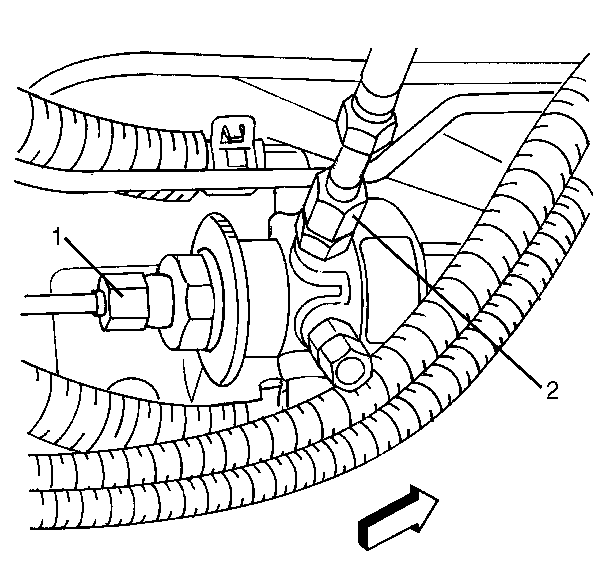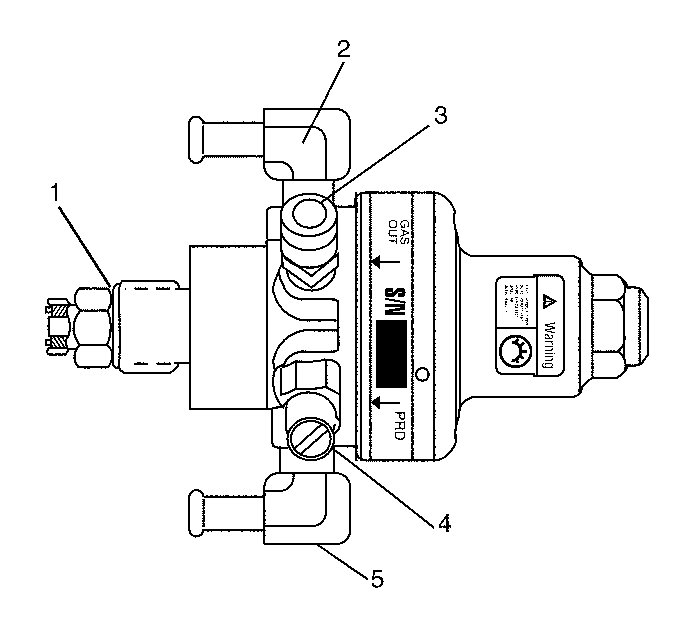Removal Procedure
Caution: Natural gas is highly flammable. In order to reduce the risk of fire and personal injury, keep sparks, flames, and smoking materials away from the vehicle while you perform the Compressed Natural Gas (CNG) fuel system service.
- Relieve the CNG fuel system pressure. Refer to the Fuel Pressure Relief .
- Disconnect the negative battery cable.
- Install hose pinching pliers on the coolant hoses near the high pressure regulator (HPR).
- Disconnect the coolant hoses at the HPR.
- Disconnect the line union to HPR fuel line (1) at the HPR. Discard the O-ring face seal.
- Disconnect the HPR to intake manifold union fuel line (2) at the HPR.
- Remove the frame rail nuts.
- Remove the backing plate (3) from the frame rail.
- Remove the HPR (1) and bracket (2) from the frame rail.
Caution: The Compressed Natural Gas (CNG) system operates at pressures up to 24820 kpa (3600 psi). Relieve the CNG fuel system pressure before servicing CNG fuel system components in order to reduce the risk of fire and personal injury.
Caution: Unless directed otherwise, the ignition and start switch must be in the OFF or LOCK position, and all electrical loads must be OFF before servicing any electrical component. Disconnect the negative battery cable to prevent an electrical spark should a tool or equipment come in contact with an exposed electrical terminal. Failure to follow these precautions may result in personal injury and/or damage to the vehicle or its components.


Disassemble Procedure
Use the following procedure if any HPR fittings require replacement:
- Remove the coolant inlet and outlet hose fittings (2,5).
- Remove the pressure relief device (PRD) (4).
- Remove the fuel outlet fitting (3).
- Remove the fuel inlet fitting (1). Discard the O-ring face seal.
- Remove the HPR bracket nut.
- Remove the HPR bracket washer.
- Remove the bracket from the HPR.

Important: Do not hold the HPR using the hex flange (near the warning label) of the HPR cover. Mount the HPR and bracket assembly in a suitable holding fixture prior to removing the bracket nut.
Assemble Procedure
Use the following procedure if any HPR fittings require replacement:
- Install the fuel inlet fitting (1) using a new O-ring face seal. Lubricate the O-ring face seal with petroleum jelly or equivalent.
- Install the fuel outlet fitting (3).
- Install the PRD (4).
- Install the coolant hose inlet and outlet fittings (2 and 5).
- Install the HPR (1) to the bracket (2).
- Install the HPR bracket washer.
- Install but do not tighten the HPR bracket nut.

Notice: Use the correct fastener in the correct location. Replacement fasteners must be the correct part number for that application. Fasteners requiring replacement or fasteners requiring the use of thread locking compound or sealant are identified in the service procedure. Do not use paints, lubricants, or corrosion inhibitors on fasteners or fastener joint surfaces unless specified. These coatings affect fastener torque and joint clamping force and may damage the fastener. Use the correct tightening sequence and specifications when installing fasteners in order to avoid damage to parts and systems.
Important: Apply pipe thread sealant with Teflon® to the threads of the fuel outlet fitting (3), pressure relief device (4) and coolant hose inlet and outlet fittings (2 and 5) before installation. Do not use Teflon® tape.
Tighten
Tighten the fuel inlet fitting to 48 N·m (35 lb ft).
Tighten
Tighten the fuel outlet fitting to 34 N·m (25 lb in).
Tighten
Tighten the pressure relief device to 34 N·m (25 lb in).
Tighten
Tighten the coolant hose inlet and outlet fittings finger tight plus
one to three turns.

Installation Procedure
Tools Required
J 41416 Ultrasonic Leak Detector
- Install the HPR and bracket (1) to the frame rail.
- Install the backing plate (3) to the frame rail.
- Install the frame rail nuts.
- Tighten the bracket nut.
- Connect the HPR to intake manifold union fuel line (2).
- Connect the line union to HPR fuel line (1) using a new O-ring face seal. Lubricate the new O-ring face seal with petroleum jelly or equivalent.
- Connect the coolant hoses to the HPR.
- Remove the hose pinching clamps from the coolant hoses.
- Connect the negative battery cable.
- Start the vehicle and use the J 41416 Ultrasonic Leak Detector in order to inspect for CNG fuel leaks at each serviced fitting.
- Inspect the coolant level in the recovery reservoir. Add coolant if necessary.

Tighten
Tighten the nuts to 11 N·m (96 lb in).
Important: Do not hold the HPR using the hex flange (near the warning label) of the HPR cover. Place a wrench between the HPR and the vehicle frame in order the keep the HPR from spinning in the bracket.
Tighten
Tighten the nut to 54 N·m (40 lb ft).

Tighten
Tighten the fuel line fitting to 15 N·m (11 lb ft).
Caution: Natural gas is stored under high pressure. If a leak occurs, the high pressure could cause a personal injury. In order to prevent Compressed Natural Gas (CNG) fuel leaks, always replace the CNG fuel system O-rings during service.
Tighten
Tighten the fuel line fitting to 24.4 N·m (18 lb ft).
Tighten
Tighten the bolt to 15 N·m (11 lb ft).
